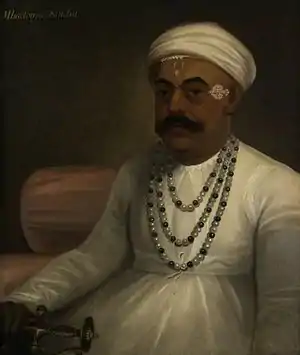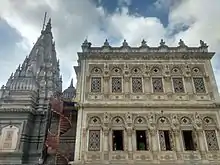Mahadaji Shinde
Mahadaji Shinde (3 December 1730-12 February 1794) also spelled as Mahadji Scindia was a Maratha Statesman and ruler of Ujjain in Central India. He was the fifth and the youngest son of Ranoji Rao Scindia, the founder of the Scindia dynasty.
| Mahadji Shinde | |||||
|---|---|---|---|---|---|
| Meherban Shrimant Sardar Shinde Bahadur (High and Brave Chief of the Shinde) Vakil-ul-Mutlaq (Regent of the Empire) Amir-ul-Umara (Head of the Amirs)[1] Udaipur Diwan Saheb (Regent of Udaipur State)[2] | |||||
 Mahadaji Shinde by James Wales | |||||
| Reign | 18 January 1768 — 12 February 1794 | ||||
| Coronation | 18 January 1768 | ||||
| Predecessor | Manaji Rao Shinde | ||||
| Successor | Daulat Rao Shinde | ||||
| Born | 3 December 1730 | ||||
| Died | 12 February 1794 (aged 64) Wanawadi, Pune, Maratha Empire (present-day Maharashtra, India) | ||||
| Spouse | 9 wives
| ||||
| Issue | Daulat Rao Shinde (adopted son) Bala Bai Chimna Bai | ||||
| |||||
| House | Shinde | ||||
| Father | Ranoji Rao Shinde | ||||
| Mother | Chima Bai | ||||
| Religion | Hinduism | ||||
The Maratha Resurrection in North India
Mahadaji was instrumental in resurrecting Maratha power in North India after the Third Battle of Panipat in 1761, and rose to become a trusted lieutenant of the Peshwa, leader of the Maratha Empire. Along with Madhavrao I and Nana Fadnavis, he was one of the three pillars of Maratha Resurrection. During his reign, Gwalior became the leading state in the Maratha Empire and one of the foremost military powers in India. After accompanying Shah Alam II in 1771 to Delhi, he restored the Mughals in Delhi and became the Vakil-ul-Mutlaq (Regent of the Empire)'.[3] Mahadji Shinde's principal Advisors were all Shenvis.[4]
He annihilated the power of Jats of Mathura and during 1772-73 he destroyed the power of Pashtun Rohillas in Rohilkhand and captured Najibabad. His role during the First Anglo-Maratha War was greatest from the Maratha side since he humbled the British in the Battle of Wadgaon which resulted in the Treaty of Wadgaon[5] and then again in Central India, single handed, which resulted in the Treaty of Salbai in 1782, where he mediated between the Peshwa and the British. In 1782, Mahadaji Shinde, fought and defeated Timur Shah Durrani who had attacked Lahore to gain it back from the Sikhs. The Maratha force under Mahadaji Shinde confronted his Afghan army and swiftly defeated and then routed them. After defeating the Afghans, Mahadji Shinde and the Marathas successfully brought back three silver gates taken from Somnath Temple which were stored in Lahore. He brought them back to Somnath but the priests of Gujarat refused to accept them and place them back on Somnath Temple so he decided that these silver gates were to be placed in the temples of Ujjain instead. Today, they can be seen in two temples of Madhya Pradesh, Mahakaleshwar Jyotirlinga, and Gopal Mandir of Ujjain. In 1787, Mahadji attempted to invade Rajputana but he was repulsed by the Rajput armies at Lalsot. In 1790, he successfully defeated the Rajput kingdoms of Jodhpur and Jaipur in the battles of Patan and Merta.
Treaty of Salbai
After the British defeat, Hastings through Murre proposed a new treaty, known as the Treaty of Salbai, between the Peshwa and the British that would recognize Sawai Madhavrao as the Peshwa and grant Raghunath Rao a pension. The treaty also returned to Shinde all his territories west of the Yamuna and so was made to withdraw to Ujjain. A resident, Mr. David Anderson (1750-1825), of St. Germains[6] (who had negotiated the treaty) was at the same time appointed to Mahadji's court.
After the Treaty of Salbai in 1782, he invaded and overpowered the Rajput states, particularly Jodhpur and Jaipur through the Battle of Patan and the Battle of Merta. Mahadji also ruled the Punjab for a brief period of time in 1790 in which the Sikh sardars and other Rajas of the Sutlej region paid tributes to him.[7]
Later years
Mahadji became Naib Vakil-ul-Mutlaq (deputy regent of Mughal affairs), and the Mughals also gave him the title of Amir-ul-Umara (head of the amirs) in 1784.[8]
Another achievement of Mahadji was his victory over the Nizam of Hyderabad's army in a battle. The Nizam state ceased to be a factor in the north Indian politics after this battle and it generally confined itself in the Deccan afterwards. After the peace made with Tipu Sultan of Mysore in 1792, Mahadji exerted his influence to prevent the completion of a treaty between the British, the Nizam of Hyderabad, and the Peshwa, directed against Tipu.
Death and legacy

After the Battle of Lakheri, Mahadji was now at the zenith of his power, when he died, at his camp at Wanavdi near Pune on 12 February 1794. He left no heir, and was succeeded by Daulat Rao Scindia.
Keeney, the English biographer of Mahadaji Shinde, has described Mahadaji as the greatest man in South Asia in the 18th century.[9] Mahadaji Shinde's role was instrumental in establishing Maratha supremacy over North India.
Shinde Chhatri, located in Wanawadi, in Pune is a memorial dedicated to Mahadji Shinde. It is a hall that marks the spot of Mahadji Shinde's cremation on 12 February 1794. The three storied memorial in Rajput architectural style, is one of the most significant landmarks in the city.
In popular culture
- In 1994, a TV series named The Great Maratha aired on DD National based on the life of Mahadaji Shinde. Shahbaz Khan portrayed the character of Mahadji Shinde.[10]
See also
References
- Page 334, A Comprehensive History of Medieval India: Twelfth to the Mid-Eighteenth Century, By Salma Ahmed Farooqui, Publisher: Pearson Education India, 2011, ISBN 8131732029
- Rajasthan Through the Ages By R.K. Gupta, S.R. Bakshi pg 255
- Vakil-ul-Mutlaq (Regent of the Empire)'
- Rathod, N. G. (1994). The Great Maratha Mahadaji Shinde - N. G. Rathod - Google Books. ISBN 9788185431529. Retrieved 21 July 2012.
- Athale, Colonel Anil A (12 January 2018). "How a Maratha general defeated the British". Rediff News.
- Burkes Landed Gentry: Anderson of Northfield
- Chaurasia, R. S. (2004). History Of The Marathas - R.S. Chaurasia - Google Books. ISBN 9788126903948. Retrieved 26 May 2012.
- Ahmed, Farooqui Salma (2011). A Comprehensive History of Medieval India: From Twelfth to the Mid ... - Farooqui Salma Ahmed, Salma Ahmed Farooqui - Google Books. ISBN 9788131732021. Retrieved 21 July 2012.
- Page 156, The Great Maratha Mahadaji Scindia, By N. G. Rathod, Publisher: Sarup & Sons, 1994, ISBN 8185431523, 9788185431529
- "Metro Plus Chennai / Telewatch : The return of the Sultan". The Hindu. 17 May 2006. Retrieved 20 July 2012.
Further reading
- Hunter, William Wilson, Sir, et al. (1908). Imperial Gazetteer of India, Volume 12. 1908–1931; Clarendon Press, Oxford.
- Keene, H. G. The Fall of the Moghul Empire of Hindustan e-text
- Markovits, Claude (ed.) (2004). A History of Modern India: 1480–1950. Anthem Press, London.
- [श्रीनाथ माधवजी : महायोद्धा महादजी की शौर्यगाथा / प्रथम संस्करण / प्रकाशन वर्ष - २०१३ / लेखक :- पण्डित नीलेश ईश्वरचन्द्र करकरे] / (Research book) Shreenath Madhavji: Mahayoddha Mahadji Ki Shourya Gatha/ First Edition / Published 2013/ Author :- Pandit Neelesh Ishwarchandra Karkare
- Amitabh Mishra (1 January 2007). Heritage Tourism in Central India: Resource Interpretation and Sustainable Development Planning. Kanishka Publishers, Distributors. p. 42. ISBN 978-81-7391-918-3.
- "Mosque and Tomb of the Emperor Sultan Mahmood of Ghuznee". British Library. Retrieved 1 November 2014.
- 101 pilgrimages. Outlook India Pub. 2006. p. 79
External links
| Wikimedia Commons has media related to Mahadaji Scindia. |
Mahadaji Shinde Born: 3 December 1730 Died: 12 February 1794 | ||
| Regnal titles | ||
|---|---|---|
| Preceded by Manaji Rao Scindia |
Maharaja of Gwalior 1768–1794 |
Succeeded by Daulat Rao Scindia |
